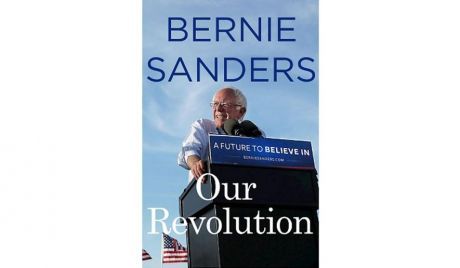Arts
You are here
Review: Our Revolution, A Future To Believe in

September 25, 2017
When I share with others that I’ve read Our Revolution: A Future To Believe In by Bernie Sanders, I can see their eyes light up, and with a big smile on their face they almost always reply “Wow! I wanted to read that! How is it?” … and then I have a decision to make. Do I take five minutes to explain my convoluted and complex feelings on the work, or do I simply smile and say “Good! You know Bernie, he’s the best!”? Well, I usually opt for the later, and have accidentally lied about this book on several occasions. As someone who still feels the Bern and adores Mr. Bernard Sanders, this book was not what I was expecting, and part of this lies in how he has written the work to be two stand-alone parts.
Part One is entitled “Running for President” and is essentially a first-person narrative of Sanders’ life that is informative and inspiring. Part Two is entitled “An Agenda for a New America: How We Transform Our Country” and contrasts with part one in its provision of a very dense, didactic breakdown of American governmental policies of past and present that contain statistics and figures on a large range of issues. Sanders writes in an accessible way with straight-forward language, but this half of the book pontificates on absolutely every diminutive social justice issue and as such can read like a dry first-year Sociology textbook at times.
Political narrative
Part One is how I anticipated the entire book would unfold. Sanders shares about his early life growing up in Brooklyn, and how he learned politics through reading magazines in The University of Chicago’s library. He joined the Young People’s Socialist League (YPSL), the Student Peace Union (SPU), and the Congress of Racial Equality (CORE), to which he eventually became CORE’s Vice President. When describing his involvement in politics during University, he includes a picture of himself protesting Chicago schools’ segregation of children, and in a very diplomatic fashion captions the photo “The photograph that drew so much attention during the campaign.”
This commentary exemplifies the diplomatic rhetoric that Sanders is known for, and his authentic voice does shine through this work; for example, he continually refers to Hillary as “Secretary Clinton” as he is known to do in interviews. His involvement in politics while in university led him to journalism where he worked for several Vermont papers; he then ran for the Liberty Union Party and won. He details his political career in Vermont, the major wins that his campaign experienced, how he then became mayor and senator, and lists various progressive policies he passed. He also emphasizes the importance of talking with the everyday American, and he often includes personal anecdotes about the struggles from his supporters in his writing.
Issues and statistics
Part Two is a departure from his personal narrative, and includes a lot of information that can be common knowledge to those who closely follow American politics and already have socialist ideals. This part would be a fantastic resource for someone who is just learning about progressive ideas for the first time, and perhaps that is his target demographic. He covers issues (from an American perspective) such as health care, private prisons, institutionalized racism, student debt, climate change and fracking, large corporations funding the media, mental health, immigration reform and the DREAM Act, trade policies, poverty, and much more.
There are charts and figures that show the gender pay gap according to race and ethnicity, student debt, international rates of incarceration, and CEO to worker compensation ratios, which are valuable resources, but are repetitive to most socialists. I was hoping this section would present the issues in a narrative style to keep the reader interested, in a similar way to Elizabeth Warren’s Fighting Chance, but it did not. There was definitely new information for myself, such as information on Wall Street’s Robert Rubin, Henry Paulson, Tim Geithner, and Alan Greenspan, but overall part two presented fact list after fact list and I had to read and re-read this part in several sittings.
This book is a good resource for those interested in Bernie Sander’s voting track record, and those wanting to learn more about American issues; however, readers are to be aware of the contrast between the two parts and that the second half of the book might cool off the Bern you’ve been feeling if you expected a more personal and interesting presentation of the material.
Section:
Topics:










